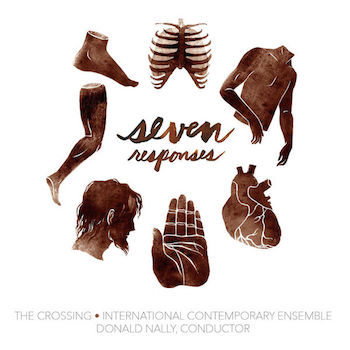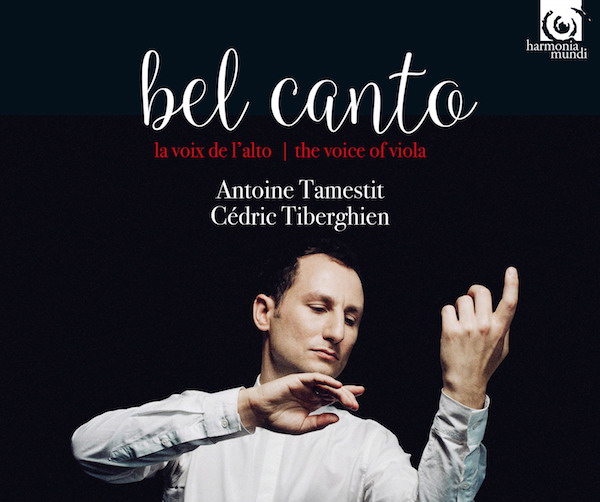Classical Music CD Reviews: Seven Responses and Bel Canto
The Crossing’s new disc presents new music at its best. For terrific viola playing and some fresh repertoire by familiar names, look no further than Antoine Tamestit’s Bel Canto.
By Jonathan Blumhofer

Sometimes you come across a concept that just works. Such is the case with The Crossing’s Seven Responses, a set of choral works that offer contemporary replies to each of the cantatas that comprise Dietrich Buxtehude’s oratorio Membra Jesu nostri. In the original, each cantata addresses one of Jesus’ limbs hanging on the cross. The contemporary entries are, perhaps unsurprisingly, less explicitly Christo-centric. But they do illuminate, in sometimes very powerful and creative ways, themes that Buxtehude’s work explored, decked out now in recognizably contemporary garb.
It certainly didn’t hurt that The Crossing, a Philadelphia-based choir led by Donald Nally, cast such a wide net for their commissions.
Caroline Shaw’s To the Hands opens the album from Innova. It’s a meditation on the activities of those appendages, using texts that focus in particular on the treatment of those in need. She includes a paraphrase of Emma Lazarus’ “The New Colossus,” her own retrospective writings, and a recitation of statistics from 2015 from the Internal Displacement Monitoring Centre, the latter being an organization that tracks individuals who have been displaced within their own country “due to armed conflict, situations of generalized violence or violations of human rights.”
Neither the texts nor their settings are at all preachy, though: Shaw’s a young composer with a very mature sense of how to make a strong musical argument on a serious topic with subtlety – not a gift to take for granted. Her musical language, which is a smart, crafty blend of contemporary techniques and nods to the past (in this case quotations from Buxtehude’s oratorio), is both beautiful and ensures the musical and dramatic success of her settings. It also lends some moral weight to the score, clearly anchoring it in a long tradition of art that takes a principled stand.
Lewis Spratlan’s Common Ground (focusing on the chest) takes up, in a bit of a stretch, an environmental theme. Cast as a tale of two characters, Tomás and Angelica, the latter of whom suffers from “a fatal environmental disease,” and with the choir serving as a kind of Greek Chorus, the piece weaves its way through a series of stages that move from grief and remorse to enlightenment, redemption, and (hopefully, one imagines) positive action.
Other installments are more abstract but deal with enduring themes. Hans Thomella’s I come near you takes as its motive suffering by, as its composer writes, “anyone or anything enduring pain for me, us, our lifestyle.” His settings of words by Arnulf of Leuven and Song of Solomon are dense and dissonant, evoking screams and torment; and yet, there’s an austere beauty to be found in it, too, especially as the piece nears its climax.
In a similar vein, Santa Ratniece’s My soul will sink within me sets excerpts from four mystical letters by St. Clare of Assisi. Ratniece’s writing, which unfolds in slowly-moving blocks, ably captures the spirit of its profound, esoteric texts and she throws just enough unexpected devices – florid vocal melismas near the music’s apex, snare drum waves, and the like – into the mix to thoroughly enchant the ear as well.
The remaining works tackle, respectively, the emotions of the heart, humility, and ritual.
Ad cor, which premiered just three days before composer Pelle Gudmundsen-Holmgreen’s untimely death from cancer, is fresh and uncompromising, building to a furious, cacophonic culmination: joy, sorrow, hope, and pain fighting each other all at once.
Anna Thorvaldsdottir’s Ad Genua/To the knees, some awkward text-setting aside, is a sumptuous rumination on longing for beauty in the face of pain and difficulty. If you only know Thorvaldsdottir from her haunting orchestral and solo tapestries, this will not disappoint; if you don’t, here’s a great “in” to her music.
And David T. Little’s dress in magic amulets, dark, from My Feet reflects on the use of crucifixion nails as amulets. Ostensibly inspired (in part) by extreme metal, it never quite explodes, rhythmically or sonically, as you might expect it to. But, with its long drones, opaque textures, and intriguing gestures (like the recurring rattle of triangle beaters on brake drums), Little’s crafted a suitably hypnotic musical space.
The performances are all excellent. The Crossing dives right in to this repertoire, singing it with style and understanding. They’re joined by members of the International Contemporary Ensemble, who provide shapely, understated accompaniments. In all, this is a powerful, moving, and thought-provoking demonstration of new music at its best.

For terrific viola playing and some fresh repertoire by familiar names, look no further than Antoine Tamestit’s Bel Canto, a survey of (mostly) French Romantic viola repertoire out now on Harmonia mundi. That the instrument was maligned as a vehicle for what Berlioz called “second- or third-rate violinists” for much of its history certainly didn’t stop plenty of first-rate violinists (and “extremely bad” guitar players, as Berlioz once described himself) from writing wonderful music for it.
Henri Vieuxtemps, whose fiddle showpieces and seven violin concertos are no strangers to recital programs, was one of them and he serves as the anchor of Tamestit’s program. His Sonata in B-flat is a brilliant vehicle for the instrument, delicately-crafted and putting the viola through its paces. But it always comes through in its best light, be that in the deep-throated, noble introduction to the first movement; the tempestuous middle Barcarolle; or the Polacca-like finale. Much the same can be said for Vieuxtemps’ dark-hued Elegie (with its surprisingly forceful coda) and the solo Capriccio.
The instrument’s flexibility and capacity for virtuosity is well-served in Jacques-Férrol Mazas’ Le Songe and Casimir-Ney’s 15th unaccompanied Prélude, the latter displaying the same sort of spectacular vivacity found in Paganini’s Caprices. And the Mazas, which is based on an aria from Donizetti’s La Favorite, covers much technical ground itself, including extended sections of glassy artificial harmonics.
Tamestit isn’t fazed by any of the challenges these pieces present. He plays with stunning precision and wonderfully consistent, buttery tone. The ease with which he navigates these pieces’ vicissitudes and, at the same time, gets them to sing so warmly is breathtaking. Cédric Tiberghien, a crackerjack solo pianist in his own right, is Tamestit’s inspired accompanist, shaping and coloring the keyboard writing – especially in the Vieuxtemps Sonata – with sensitivity and an ear for coloristic affect.
Filling out the album are three operatic arias – “Casta diva” from Bellini’s Norma, “Il faut partir” from Donizetti’s La fille du Régiment, and “Ô mon Femand” from La Favorita – that, like everything else here, sing with passion.
Jonathan Blumhofer is a composer and violist who has been active in the greater Boston area since 2004. His music has received numerous awards and been performed by various ensembles, including the American Composers Orchestra, Kiev Philharmonic, Camerata Chicago, Xanthos Ensemble, and Juventas New Music Group. Since receiving his doctorate from Boston University in 2010, Jon has taught at Clark University, Worcester Polytechnic Institute, and online for the University of Phoenix, in addition to writing music criticism for the Worcester Telegram & Gazette.
Tagged: Antoine Tamestit, Bel Canto, Harmonia Mundi, Innova, Seven Responses
